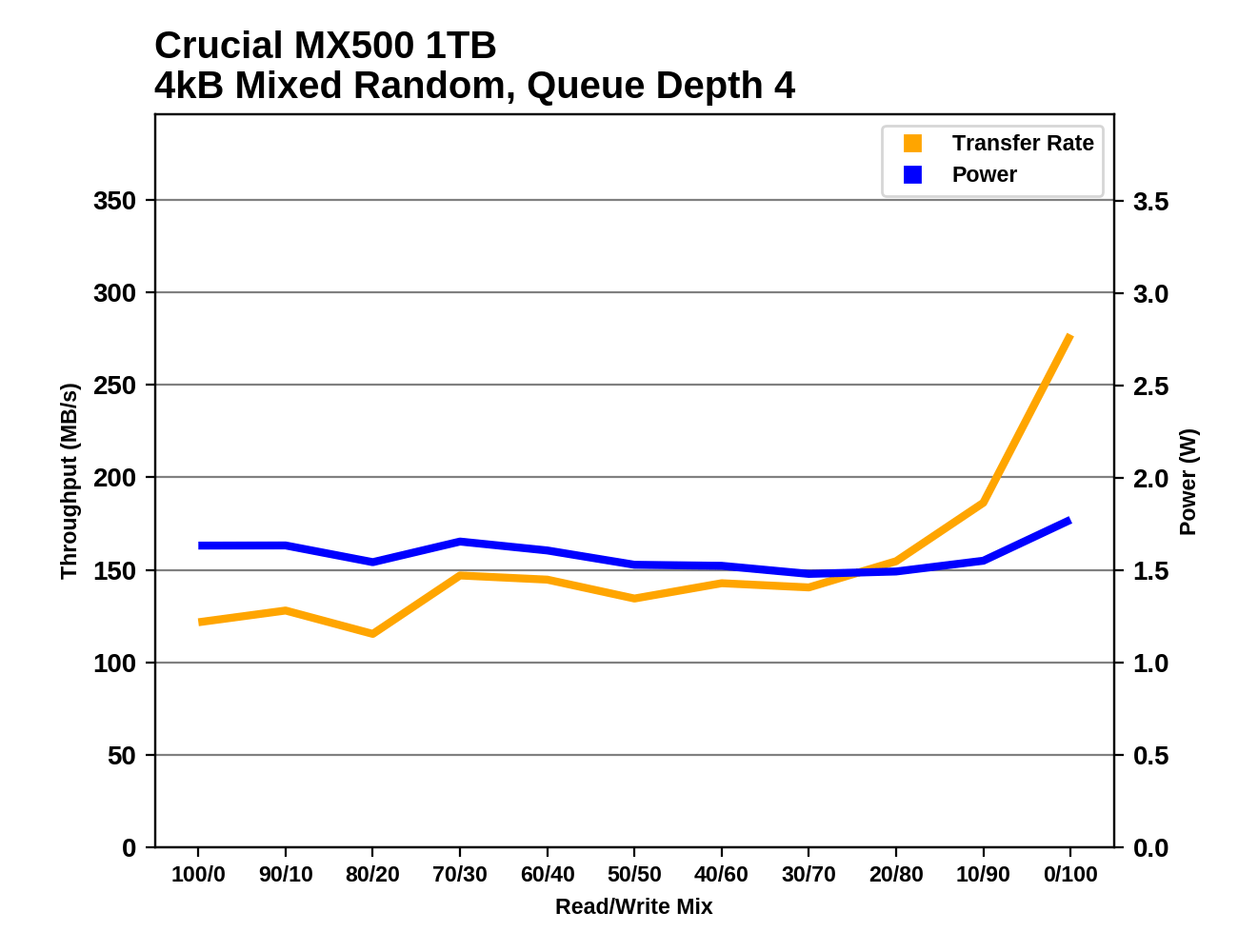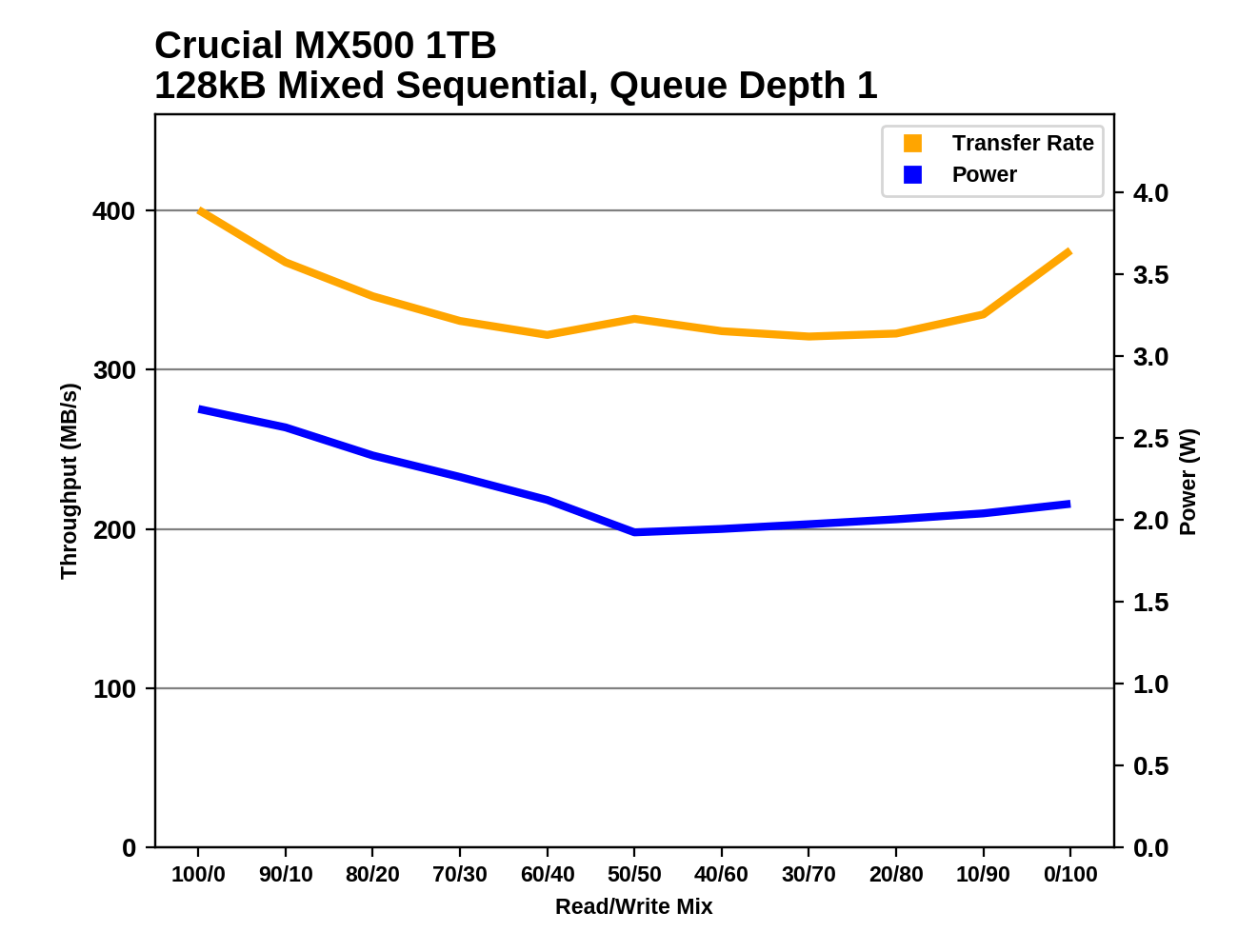The Crucial MX500 1TB SSD Review: Breaking The SATA Mold
by Billy Tallis on December 19, 2017 8:00 AM ESTMixed Random Performance
Our test of mixed random reads and writes covers mixes varying from pure reads to pure writes at 10% increments. Each mix is tested for up to 1 minute or 32GB of data transferred. The test is conducted with a queue depth of 4, and is limited to a 64GB span of the drive. In between each mix, the drive is given idle time of up to one minute so that the overall duty cycle is 50%.

The mixed random I/O performance of the Crucial MX500 is slightly slower than both the MX300 and the Intel 545s, but still above average for mainstream SATA SSDs. The 64L 3D TLC drives from Toshiba and Western Digital/SanDisk are significantly slower, and the Samsung 850 PRO and 850 EVO are still the fastest for this test.

The Crucial MX300 and Intel 545s are tied for first place for power efficiency on this test, with the MX500 coming in third place and well ahead of the other mainstream SATA drives.
 |
|||||||||
The Crucial MX500's performance during this test is a bit unsteady but generally good during the first half when the workload is more read-heavy. The MX500's speed picks up significantly when the workload becomes very write-heavy, but it take too long to start speeding up; other drives like the Samsung 850 PRO and EVO are steadily accelerating with increasing proportion of writes, starting fairly early in the test.
Mixed Sequential Performance
Our test of mixed sequential reads and writes differs from the mixed random I/O test by performing 128kB sequential accesses rather than 4kB accesses at random locations, and the sequential test is conducted at queue depth 1. The range of mixes tested is the same, and the timing and limits on data transfers are also the same as above.

The Samsung 850 PRO and EVO are the fastest SATA drives on the mixed sequential I/O test, and the Crucial MX500 falls into the second tier of drives, along with the other mainstream 64L 3D TLC drives and the MX300.

The Toshiba TR200 and OCZ VX500 score highest on power efficiency for the mixed sequential I/O test because they include little or no DRAM. The MX500 scores reasonably well overall but worse than the MX300 and the Intel 545s.
 |
|||||||||
The Crucial MX500 performs well in the early, read-heavy phases of the test but performance drops toward the middle and only recovers slightly at the end of the test. The minimum performance level across the entire test is quite high, but the fastest drives spend much less time performing at or near their minimum.










90 Comments
View All Comments
Kristian Vättö - Tuesday, December 19, 2017 - link
The BX300 is merely a vehicle to consume low yielding MLC wafers.oRAirwolf - Tuesday, December 19, 2017 - link
Can you expand on that statement? Low yielding in what ways?hojnikb - Tuesday, December 19, 2017 - link
Probably not as good performing (endurance, write performance) dies get used with bx300 instead of discarding them or using them elsewhere.jabber - Tuesday, December 19, 2017 - link
But where else would Crucial be using the good MLC ones if everything else is TLC?cblakely - Tuesday, December 19, 2017 - link
Enterprise productsKristian Vättö - Wednesday, December 20, 2017 - link
Most of it is going to mobile and industrial applications, of which both have very strict quality requirements. The ones that don't meet the criteria can either be sold as wafer/component or used in a retail client SSD, the latter obviously having a better profit margin.Memory is yielded at wafer level. Dies from a low yielding wafer statistically have a higher probability of failure in long-term, even if individual dies are OK in initial probing.
sonny73n - Wednesday, December 20, 2017 - link
WTH are you talking about? Testing endurance and write performance of every die? It's not common sense at all. Therefore, you're a bullshit.FunBunny2 - Wednesday, December 20, 2017 - link
"WTH are you talking about? Testing endurance and write performance of every die? It's not common sense at all. Therefore, you're a bullshit. "that's not what he said. what he said was, post mortem analyses have shown that wafers with a low yield produce dies with short lifespans. those dies are then shipped out as retail SSD.
emvonline - Tuesday, December 19, 2017 - link
Kristian is a wise man. BX300 is a pragmatic response ... not a strategy. MX500 is very well positionedmalventano - Tuesday, December 19, 2017 - link
Low yield MLC wafers would likely not produce usable TLC dies with a higher endurance rating than Samsung's currently shipping V-NAND.